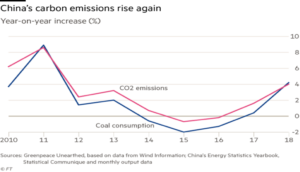According to the Environmental Protection Agency (EPA), U.S. greenhouse gas emissions dropped 2.7 percent from 2016 levels in 2017 with emissions from large power plants falling 4.5 percent. Emissions of carbon dioxide (the largest component of greenhouse gases) on a per-capita basis hit a 67-year low in 2017. U.S. carbon dioxide emissions in 2017 are the lowest since 1992 and per-capita emissions are the lowest since 1950. According to Acting EPA Administrator Andrew Wheeler, “These achievements flow largely from technological breakthroughs in the private sector, not the heavy hand of government.”
In contrast, greenhouse gas emissions globally increased in 2017 and are set to increase to historic highs by the end of this year, despite the Paris climate accord. China leads the world in greenhouse gas emissions and India and other developing countries also contribute to the global increases.
European countries are not on track to meet their own emissions reduction goals under the Paris accord. For example, Germany is expected to miss its 2020 emissions targets and will likely push its goal of cutting carbon dioxide emissions back to 2030.
The United States led the world in carbon dioxide emissions cuts for the ninth time this century, according to BP’s Statistical Review of World Energy. According to BP, the European Union increased its carbon dioxide emissions by 1.5 percent, with Spain accounting for 44 percent of the increase. German and French carbon dioxide emissions increased 0.1 and 2 percent, respectively, while the United Kingdom and Denmark reported the lowest carbon dioxide emissions since 1965 when BP’s data series began.
EPA’s Report on Greenhouse Gas Emissions
The Inventory of U.S. Greenhouse Gas Emissions and Sinks (Inventory), produced annually by EPA for over 20 years, estimates total greenhouse gas emissions across all sectors of the economy using national-level data. EPA’s Greenhouse Gas Reporting Program collects detailed emissions data from over 8,000 of the largest greenhouse gas emitting facilities in the United States, covering approximately 85 to 90 percent of total U.S. greenhouse gas emissions.
China’s Carbon Dioxide Emissions Continue to Increase
China’s carbon dioxide emissions are expected to increase at their fastest pace in over seven years during 2018. Carbon dioxide emissions in China—the world’s largest emitter of greenhouse gases—increased 4 percent in the first quarter of this year, based on Chinese government statistics covering coal, cement, oil, and natural gas. If that pace continues, it would be the fastest increase since 2011.
Although China invested heavily in wind and solar power, its emissions growth comes from increased demand for oil and natural gas due to increased car ownership and increased electricity demand. Recently, China’s government approved new thermal power projects, mostly coal, in four provinces, which had been held back over fears of overcapacity.

Chinese steel output, which had appeared to have peaked in 2013, hit a new record in 2017.
Conclusion
The United States is leading all countries in reducing its greenhouse gas emissions, while other countries are having a hard time meeting their commitments to the Paris accord. China leads the world in increased carbon dioxide emissions and is on track this year to have the largest growth in carbon dioxide emissions since 2011 if its first quarter pace continues. China’s steel production, which peaked in 2013, is again on the rise. Other global countries are contributing to increased carbon dioxide emissions including India, other developing countries, and the European Union. It is of note that the one country to have announced its withdrawal from the Paris accord is leading the world in carbon dioxide reductions while simultaneously achieving enviable economic growth.